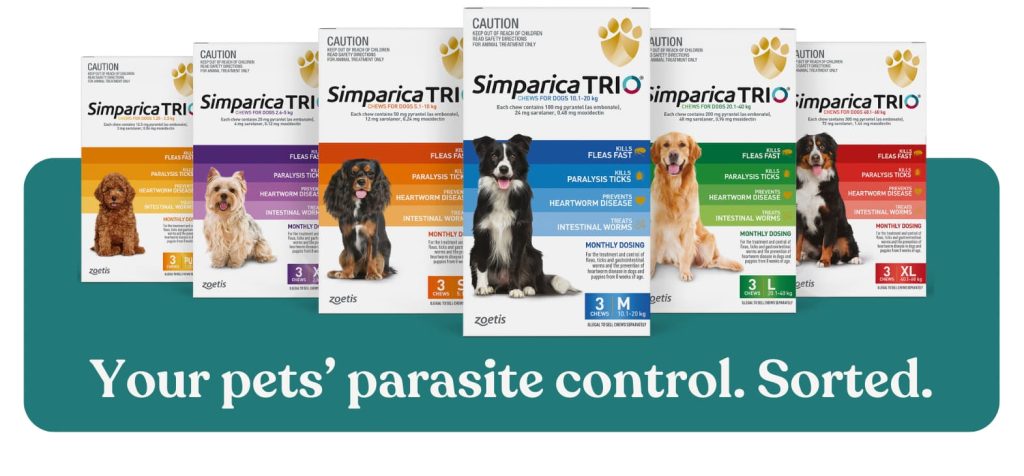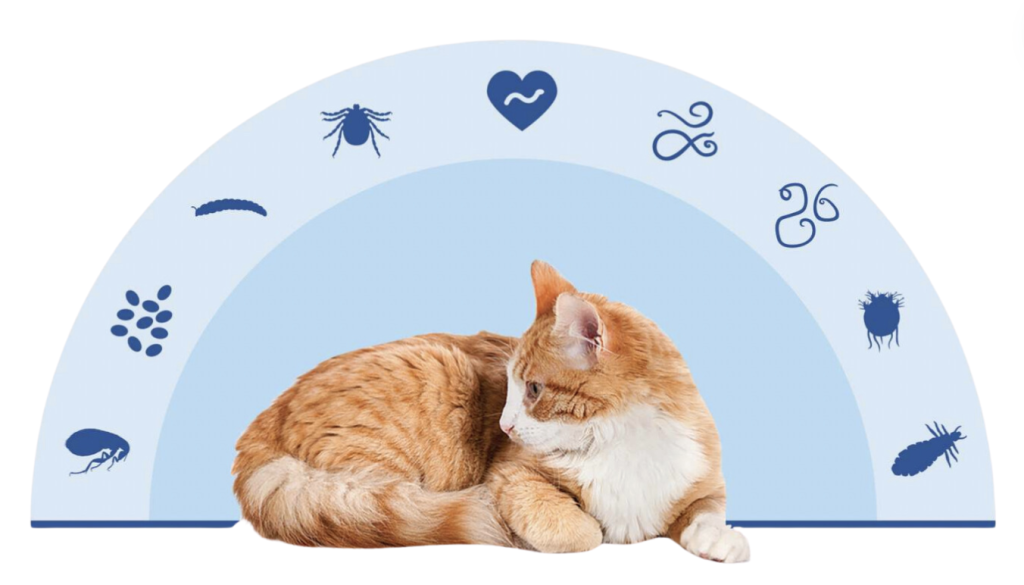We all know that as a responsible pet parent, it’s important to provide protection against nasty parasites. As you navigate through all the options, which one is best suited to your four-legged friend?
Let’s delve into the evolution of flea and tick treatment for dogs and cats, and what the advancements in medicine mean for the health and safety of our furry companions. Then we can best weigh up the options.
 The history of parasite treatments for pets
The history of parasite treatments for pets
Before the all-encompassing options we have access to today, ancient civilisations such as the Egyptians and Greeks used various botanical extracts and herbs to repel parasites from their animals. In mediaeval Europe, aromatic plants like lavender and rosemary were commonly used to ward off fleas and ticks.
Fast forward to today and the rise of medical advancements, where there are now topical spot-on treatments and oral medications (some of them in the form of tasty chews) that offer a convenient and effective solution against parasites.
Let’s break down the different flea and tick treatments available
There are several types of flea and tick treatments available for pets, and some that protect against worms and other parasites too. Each option has its own application method, level of coverage, and duration of effectiveness. Here are the most common types:
- Topical spot-on treatments: Applied directly to the skin, usually between the shoulder blades or along the back of the neck, where the pet can’t lick them off. They typically contain active ingredients that spread over the pet’s body through the skin’s oils, providing protection against fleas, ticks, and sometimes other parasites.
- Oral medications: Oral flea and tick treatments come in the form of tablets, chews, or flavoured liquids that pets can ingest. These medications work systemically, meaning they circulate in the pet’s bloodstream. So, when a flea or tick bites, it ingests the medication and is killed. This is a common treatment because your pet often sees it simply as a tasty treat – a win, win!
- Flea and tick collars: Worn around the pet’s neck and releases active ingredients that repel or kill fleas and ticks. These collars continuously release low levels of the active ingredient over time, providing long-lasting protection. Some collars work primarily to repel parasites, while others actively kill them.
- Flea and tick shampoo: Used during bathing to kill existing fleas and ticks on the pet’s coat. While they provide immediate relief, this is more of a temporary treatment that doesn’t act as a preventative measure.
- Sprays and powders: Applied directly to the pet’s coat to kill existing parasites and again, provide temporary protection. They may contain natural or synthetic ingredients and can be effective for immediate relief. Like flea shampoos however, they don’t offer long-lasting residual protection and may need to be reapplied frequently.
Natural versus scientifically formulated, which treatment is best?
While there are some natural, more holistic options available for treatment of fleas, ticks and worms – using herbal ingredients or essential oils – their effectiveness can vary considerably. And, natural doesn’t always mean safe. Essential oils can be toxic to pets if ingested or applied incorrectly. And there’s also the possibility that they can cause skin irritation or an allergic reaction.
Although no option is completely without the risk of side effects, the evolution of modern medicine means we can have confidence in the treatments that contain active pharmaceutical ingredients. Keep reading to see stats that support this.
When it comes to the best flea and tick treatment for dogs and cats, there are some great resources to help with FAQs for flea, tick and worming your pet, however it’s always recommended that you consult your Vet who can provide more personalised advice.
Factors to consider when choosing the right parasite treatment for your pet
We all just want to find a solution that will not only work but provide the highest level of protection. The challenge of sifting through an abundance of information and understanding fact v myth is very real. So, in order to help guide you to the best course of action, take these points into consideration:
- Species and breed: Different parasite treatments are formulated for specific species of pets. For cats, Revolution® PLUS is the equivalent of a dog’s Simparica TRIO® – each catering to unique sensitivities or predispositions to certain types of parasites. It’s essential to choose a treatment suitable for your pet’s species and breed.
- Age and weight: The age and weight of your pet can influence the type and dosage of parasite treatment that is safe and effective. Some treatments are not recommended for very young or very small pets, while others may have weight-specific dosing guidelines.
- Health status: Consider your pet’s overall health status, including any pre-existing medical conditions or allergies they may have. Some parasite treatments may interact with medications your pet is currently taking or exacerbate underlying health issues. Always consult your Vet if your pet has health concerns before starting a new treatment.
- Application method: Evaluate the different application methods available for parasite treatments. For example, if you’re looking for an all-in-one flea, tick and worm treatment that’s easy to administer and comfortable for your pet to receive, an oral medicine in the form of a tasty chew may be best.
- Duration of effectiveness: Some parasite treatments offer short-term protection and may require frequent reapplication, while others provide longer-lasting protection with fewer applications.
- Safety and side effects: Research the safety profile of potential parasite treatments and be aware of any potential side effects or adverse reactions that may occur. Look for treatments that have been extensively tested for safety and efficacy.
- Cost: Parasite treatments can vary significantly in cost. However, keep in mind that prevention is better than cure. So comprehensive coverage may ultimately save you money by avoiding costly infestations or health problems down the line.
So how does an all-in-one flea, tick, and worm treatment for dogs rate for effectiveness?
An all-in-one treatment will provide the most comprehensive protection for your pet, and will be the easiest to administer. Let’s take Simparica TRIO®, for example. It’s the first and only product that combines sarolaner, moxidectin, and pyrantel in one simple-to-give chewable—for protection against heartworm disease, ticks and fleas, and intestinal worms. This flea and tick treatment for dogs has undergone clinical studies and have the following results:
| Heartworm disease prevention | |
In two well-controlled laboratory studies, a single oral dose of Simparica TRIO® was 100% effective in preventing the development of heartworm disease in dogs. | |
| Tick treatment and control | |
In a well-controlled laboratory study, Simparica TRIO® began to kill deer ticks within 8 hours. FDA-approved to prevent infections that can cause Lyme disease by directly killing deer ticks. | |
| Flea treatment and prevention | |
In a well-controlled laboratory study, Simparica TRIO® began to kill fleas at 4 hours and demonstrated 100% effectiveness at 8 hours after initial administration. | |
| Intestinal parasite treatment and control | |
In a 10-day multi-centre field study, Simparica TRIO® was 99.2% effective against adult roundworm and reduction in fecal egg count.¹,²† It also demonstrated >94% effective against hookworm, in studies.4 |
†Also effective against immature stage of T. canis.³
Now, let’s review the best flea and tick treatment for cats…
When it comes to comprehensive parasite control for cats, Revolution® PLUS is proven to protect against roundworms, hookworms, and heartworm disease. Plus, it also has a unique dual action against fleas and ear mites.
| Fleas | |
Revolution® PLUS kills fleas before they lay eggs and keeps killing for a full 5 weeks.² It starts killing fleas within 6 hours with a residual speed of kill maintained through day 28 during subsequent weekly reinfestations²
The dual action of Revolution® PLUS (selamectin and sarolaner) was highly effective against fleas; Revolution (selamectin) was less effective (<80%) against positive control (isoxazoline†)3,4 | |
| Ticks | |
| |
| Ear mites | |
| |
| Roundworms | |
| |
| Hookworm | |
| |
| Heartworm disease | |
|
Simparica TRIO® and Revolution® PLUS are the world’s number 1 selling all-in-one for dogs and cats, respectively. So as a pet parent you’ll enjoy peace of mind knowing they have complete protection from nasty parasites. After all, they’re not just pets – they’re family members!






